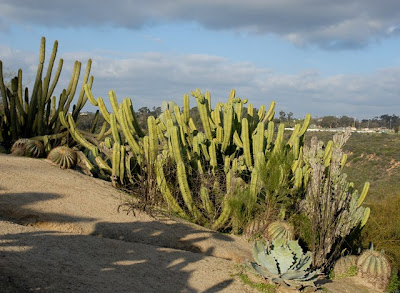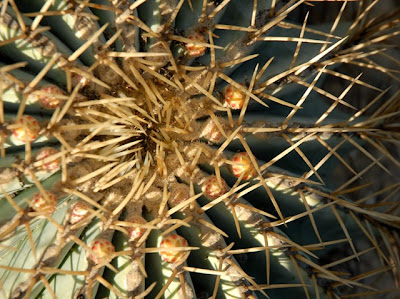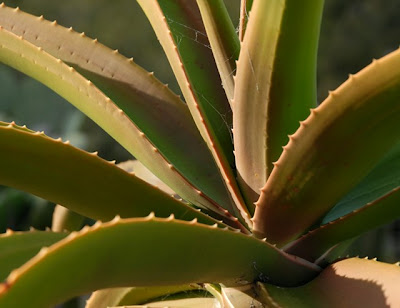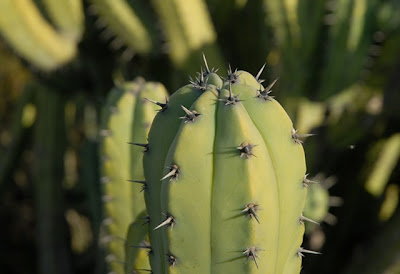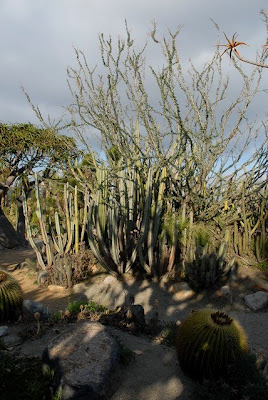Friday, February 04, 2011
Balboa Park, San Diego - The Desert Garden
As mentioned in the previous post I recently visited southern California. During a day off I and a couple of colleagues decided to visit the San Diego Zoo - I have to confess that I also had a cunning plan to lure my not-so-cacti-interested colleagues into visiting the Desert Garden located in Balboa Park just next to the Zoo.
My plan succeeded and after enjoying the fabulous Zoo we spent some quality time among the cacti and succulents growing on the slopes of the Desert Garden. Unfortunately the visit was improvised and rather badly planned so I missed the Old Cactus Garden, the Botanical Building, and several other interesting gardens in Balboa Park, places that I in hindsight would have liked to visit. Then again, now I have a good excuse for going back to San Diego ;-)
According to their website “the Desert Garden contains more than 1,300 plants, including succulents and drought-resistant plants from around the world, within its 2.5 acres. The peak blooming period is January through March”. I guess my visit in very early January was a tad too early to experience the full-throttle flower fest as only a few of the plants were blooming (several of the cacti were budding, though - again a good reason for revisiting Balboa Park ;-)
Yet another reason for coming back is that several of the pathways in the Desert Garden were closed during my visit due to heavy rains just a few days prior.
Saturday, September 05, 2009
A visit to Brooklyn Botanic Garden
As is evident from several posts on this blog I enjoy visiting botanical gardens whenever I have the chance. Spending part of my summer vacation in New York City it was natural to visit one of the city's gardens.
I went to the New York Botanical Garden a couple of years ago so this time around I wanted to have a look at one of the other botanical gardens in the NYC area. Unfortunately not all of my household are as enthusiastic about spending time in botanical gardens as I am, but I managed to lure “She Who Must Be Obeyed” into going to Brooklyn Botanic Garden using a visit to the DUMBO district in Brooklyn as a bait ;-)

Steinhardt Conservatory and the Lily Pool Terrace
Sights in the garden include a number of specialty “gardens within the garden” and the Steinhardt Conservatory that houses several climate-themed plant pavilions. Our visit fell on a very hot day with temperatures soaring above 30 C (~90 degrees Fahrenheit) and it was great to leave the confinement of the city behind for a few hours. That being said several areas of the garden gave a somewhat untended, dilapidated impression, as for example the rock garden where the outdoor cactus bed seemed at serious risk of being completely taken over by weeds.

The Desert Pavilion
Inside the Steinhardt Conservatory the Desert Pavilion houses plants from arid regions in both the Old and New World. I don't know if the heat made me grumpier than usual because I didn't find the Desert Pavilion particularly impressive either; the plants in the collection are rather ordinary, and worse, some show signs of neglect – also, an Ariocarpus fissuratus had either rotted away, been dug up, or somehow else gone missing, but even without a sign of the plant in question the tag announcing it was still left in the soil.
It didn't add to the experience that the garden's outdoor cafeteria, catering to the herd of weekend visitors, was deep-frying stuff and the resulting nauseating fumes were billowing into the hot greenhouses making them a rather unpleasant place to be.

The Desert Pavilion from a different angle
Outside the Steinhardt Conservatory lies the Lily Pool Terrace with two large pools that are planted with nearly 100 varieties of hardy and tropical water-lilies (Nymphaea species) and sacred lotus (Nelumbo nucifera) cultivars.
+.jpg)
Flowering hardy water-lily (Nymphaea sp.)
I am developing a thing about water-lilies and lotus so I ended up spending quite a while enjoying the different flowers and the distinctive lotus seed pods.
_seed_pod_20090905.jpg)
Sacred lotus (Nelumbo nucifera) seed pod
The Brooklyn Botanic Garden also houses the C.V. Starr Bonsai Museum that, according to the BBG's home page, is considered one of the finest bonsai collections in the world and is the second largest on public display outside Japan. Some of the trees in the collection are well over a century old.

Bonsai Pinus parviflora, informal upright style
I don't know much about bonsai but have to admit that the dwarfed trees are quite fascinating.

Bonsai Juniperus chinensis var. sargentii, driftwood style
The garden is easily accessible by subway – take the 2 or 3 train and get off at the Eastern Parkway – Brooklyn Museum station and walk right in.
In conclusion, if in New York City and having an urge to visit a botanical garden I would opt for the New York Botanical Garden - on the other hand I have not visited Queens Botanical Garden yet so I might end up giving that a chance also ;-)
Tuesday, May 05, 2009
The Barcelona Cactus Garden – Jardins de Mossèn Costa i Llobera
As mentioned in the previous post I recently spent some time in Barcelona, Spain.
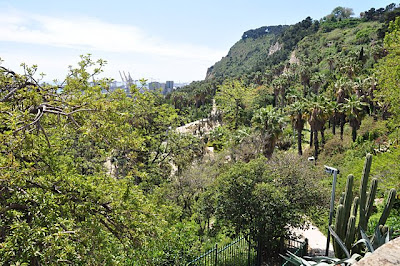
Panoramic view of Jardins de Mossèn Costa i Llobera
I had been looking especially forward to visiting the cactus garden, Jardins de Mossèn Costa i Llobera, located on the steep slopes of Mount Montjuïc that face the Mediterranean Sea and overlooked by the Montjuïc Castle (its hard to beat a location like that!), but when we arrived at the garden it was closed. We checked various signs and posters that all claimed that the garden should have opened a couple of hours prior to our arrival but all gates were locked. While I was standing sulking and disgruntled my entrepreneurial girlfriend had scanned the area and located a hole in the fence and through we went;-)

Ferocactus glaucescens flowers and a snail

A stand of Ferocactus glaucescens
It was a great experience wandering around the deserted garden – at first we lurked about, halfway expecting to be thrown out any minute, but nothing happened and soon we just enjoyed this calm and secluded cactus haven located so close to the hustle and bustle of the city.

Budding Ferocactus stainesii

Group of large Echinocactus grusonii
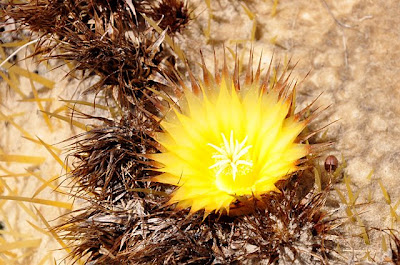
Echinocactus grusonii flower, close-up

Flowering Cleistocactus strausii
We never found an explanation for why the park was closed. Most of the park looked well tended for and ready to receive visitors but some of the more remote areas of the park had entered into a state of “lush decay” and a few foot paths were even blocked by plants.
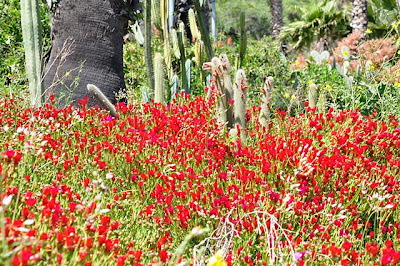
Lush decay

Blocked pathway
Later, when visiting Montjuïc Castle, I noticed a jogger crossing the cactus garden down below and leaving it through a different hole in the fence. Maybe the holes are an unofficial way of keeping a closed park open ;-)
If you're in Barcelona the park is definitely worth a visit – if you can find a way in ;-)
The video above shows a panoramic view of the central bed of the Barcelona Cactus Garden, Jardins de Mossèn Costa i Llobera. The bed features a group of massive Echinocactus grusonii (Golden Barrel Cactus) in the foreground - I have seen these described elsewhere as "clusters of round cactus that resemble a colony of alien eggs just about to hatch" ;-)
Monday, May 04, 2009
The Botanical Garden of Barcelona – El Jardí Botànic de Barcelona
I spent the last week of April vacationing in Barcelona, Spain and of course had to visit the botanical garden (even though I later had to spend hours and hours shopping and browsing shoe stores to be granted indulgence for spending a day among plants on Mount Montjuïc ;-)
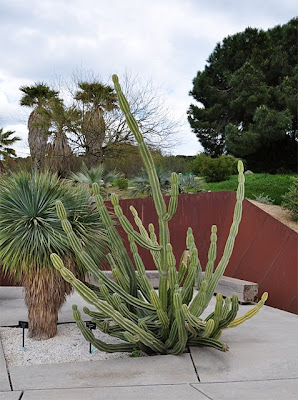
Cereus hildmannianus (hedge cactus / queen of the night)
The botanical garden of Barcelona was opened on April 18, 1999 so most of the plants are still quite young – the garden is worth a visit today but has the potential to become an absolutely amazing garden in a generation or two when the plants mature. The main focus is on plants from the Mediterranean climate regions (the homoclimatic zones of California, Chile, the Mediterranean basin, South Africa, and Southern Australia) so cacti are not predominant.
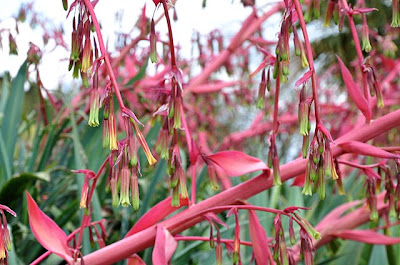
Beschorneria yuccoides flowers
Still you can find lots of interesting succulents like the stand of Beschorneria yuccoides (Mexican Lily, Red-hot poker), a stemless plant with an impressive bright red inflorescence ranging from 1 to 1.8 meter long.

Beschorneria yuccoides (Mexican Lily) stand
Speaking of fantastic inflorescences I also have to mention the Furcraea bedinghausii that flowered during our visit.

Furcraea bedinghausii flower, close-up

Furcraea bedinghausii inflorescence

Flowering Furcraea bedinghausii
The garden is situated next to the stadium, Estadi Olímpic de Montjuïc, that generates a lot of noise when a game is on. It was a slightly weird experience when the peaceful garden suddenly buzzed with the singing and shouting from the stadium.

Estadi Olímpic de Montjuïc as seen from the botanical garden
Actually two botanical gardens are located on Montjuïc. The construction work done in relation with the Olympic facilities built in 1986 seriously affected the stability of the Historic Botanical Garden and it was decided to build a new one (the one we visited). We tried to locate the historic garden, without luck (it was said to be located on the opposite side of the stadium from the new garden, but we couldn't locate it with certainty... we found what looked like an old park on some extremely steep slopes, though).
You can read more about the Botanical Garden of Barcelona at their website. If in Barcelona, make sure to also visit the Cactus Garden, Jardins de Mossèn Costa i Llobera.
Sunday, September 28, 2008
Copenhagen Botanical Garden revisited
The first weekend of September I visited Copenhagen Botanical Garden again. As described earlier the garden has a cactus house open to the general public as well as a propagation house that you can't enter. Flowering and otherwise interesting plants are put on display close to the entrance of the propagation house so even though you can't enter you still have a chance to enjoy some of the gems hidden away inside this house. An example is the beautiful flowering Ariocarpus fissuratus pictured below.

Flowering Ariocarpus fissuratus

Ariocarpus fissuratus flower
Lots of interesting plants are on display inside the publicly accessible cactus house. I especially fell for the lone Ariocarpus retusus tucked away among some larger plants.
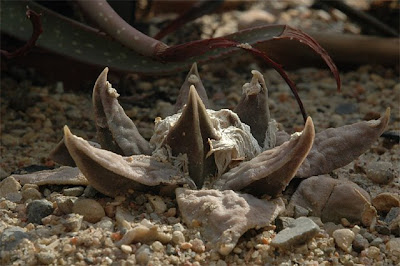
Ariocarpus retusus

Ariocarpus retusus seen from above
Another beauty growing among much larger plants is a (slightly dehydrated) Astrophytum asterias.

Astrophytum asterias
The cactus house holds a large collection of Mammillaria as for example this Mammillaria prolifera var. texana that certainly lives up to its name.

Mammillaria prolifera var. texana
Back in the propagation house a group of Strombocactus disciformis was also on display. The plants are growing in rocks mimicking their natural habitat.

Strombocactus disciformis
My previous post on the Copenhagen Botanical Garden & Museum featured several pictures of the greenhouses so I won't bring any here except for a photo showing the top of the main greenhouse reflected in the water lilly pool in front of it.

Greenhouse reflected in the water lilly pool
Thursday, August 16, 2007
Copenhagen Botanical Garden & Museum
I spent part of my summer vacation in Copenhagen and naturally had to visit the Botanical Garden and Museum. The garden is located in the center of the city and has many visitors. Unlike most other gardens and parks in Copenhagen, the purpose of the botanical garden is research. Therefore, “it is not allowed to run, to ride a bicycle, climb the trees, stay on or walk on the lawns, pick the flowers or picnic.” These rules are a gross limitation on Danes who generally light bonfires and run around naked on lawns ;-)

The Conservatory
The botanical garden was established August 2, 1600, and has moved and changed during the centuries. The fourth and present incarnation of the garden was opened to the public on October 9, 1874, 274 years after the founding of the first botanical garden (the vanes on the conservatory roof date the construction to 1873).
The cactus and succulent plants have their own dedicated greenhouse in these wonderful settings. Facing the stairs leading to the main conservatory building (the palm house), the cactus and succulent house is located to the left of the stairs, one level lower than the palm house.
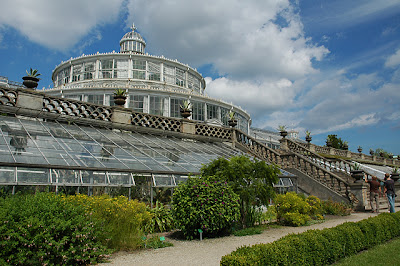
The cactus and succulent house
Inside the cactus house you’ll find an abundance of plants – both small globular types and huge columnar plants. It seems like theft of the smaller plants is a problem as they are protected by glass plates and the whole house is monitored by video.

Inside the cactus and succulent house
The plants all look vigorous and well tended for, as for example this group of flowering Astrophytum ornatum plants (for comparison you can check the A. ornatum growing in the Myriad Botanical Gardens, Oklahoma City).

Flowering Astrophytum ornatum

Astrophytum ornatum flower
A large, fat Astrophytum asterias was hiding in the shadows of the larger plants.

Astrophytum asterias
And a Mammillaria geminispina was displaying its last flowers along with a multitude of dark red fruits.
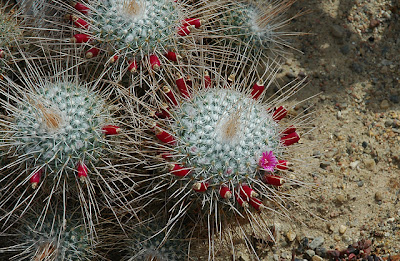
Mammillaria geminispina
Unfortunately I couldn’t find any Lophophora, Ariocarpus, or Strombocactus in the publicly accessible houses; but the garden also has houses that are not open to the public and reserved for experiments and plant propagation. Maybe it’s just wishful thinking, but I’m almost positive I glimpsed a collection of ariocarpi and a few lophs inside one of these houses.
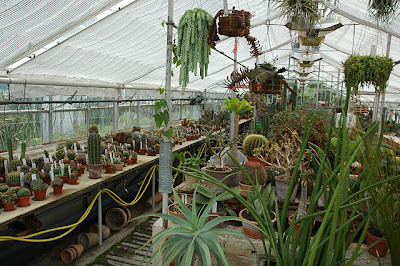
Propagation house – closed to the public
If you happen to be in Copenhagen a visit to the Botanical Garden and Museum is highly recommended. It’s a tranquil oasis situated in the center of a bustling city, and the historical conservatory buildings are beautiful in their own right (the garden was declared a preserved site on January 31, 1977). You might not find a lot of the rarer species in the houses open to the public, but the plants on display are abundant, well grown, and clearly marked.
Wednesday, July 04, 2007
A visit to Myriad Botanical Gardens and Crystal Bridge Tropical Conservatory, Oklahoma City
I recently visited Oklahoma City and had a Sunday to kill. Being within walking distance from my hotel I decided to visit the Myriad Botanical Gardens and Crystal Bridge Tropical Conservatory.
The garden functions as an urban oasis in downtown Oklahoma City with its verdant hills, perennial gardens, and a tranquil lake with koi and lots of turtles sunning themselves. The cylindrical glass shape of the Crystal Bridge Conservatory is hovering above the waters of the lake connecting its shores - a novel and interesting approach to greenhouse construction.

Crystal Bridge Conservatory
While the garden itself and the special architecture of the conservatory merit a visit I was a bit disappointed with the collection of plants kept in the conservatory. The succulent collection (growing on the so-called Dry Mountain) seems like a mishmash of unrelated and mostly unnamed plants (one of the named exceptions being a large Astrophytum ornatum (Monk's Hood)), but I'm probably heavily prejudiced by my expectations to botanical gardens as collections of plants with a scientific scope - not just a look-and-feel-good assemblage of greenery.

Astrophytum ornatum – one of the few named plants

View of the Dry Mountain
Writing this I realized that I've been consistently complaining about the quality of the cactus collections in my posts on botanical gardens – I guess I'll have to arrange a visit to the Desert Botanical Garden (Phoenix, Arizona) in order to see some real plants ;-)
All Time Most Popular Posts
-
Lophophora williamsii (peyote) populations have diminished in large areas of South Texas where peyoteros harvest the cactus for ceremonial ...
-
On various occasions I've been asked what growing media I'm using for my cactus plants. I don't have a set soil mix recipe as su...
-
Below is a list of retailers/nurseries selling cactus seed and plants. I've only listed vendors I've done business with. If you ar...
-
Most cacti are easily grown from seed - and with a little patience and care they can be grown into beautiful plants. Lophophora williamsi...
-
In last month’s post on the troubled Texan peyoteros I referred to Anderson’s article on the peyote situation in Texas. Given the importanc...
-
Yet another slightly off topic and probably not entirely politically correct post, but I couldn’t help noticing the similarity of my monstr...
-
Flowering stand of San Pedro cacti (Trichocereus pachanoi) To me the main draw of the San Pedro cactus ( Trichocereus pachanoi (syn. Ech...
-
In the June 2008 issue of the Cactus & Co magazine Jaroslav Šnicer, Jaroslav Bohata, and Vojtěch Myšák described a new Lophophora spec...
-
There seems to be an increased focus on the alarming Texas peyote situation. A couple of weeks ago the Houston Press published a mournful, i...
-
I spent two weeks working in Delhi, India during January. I had one weekend off and had planned to spend it in Delhi at my own leisure, but ...
